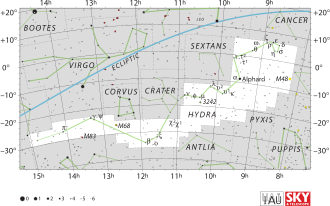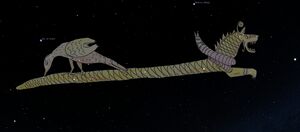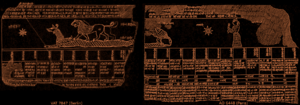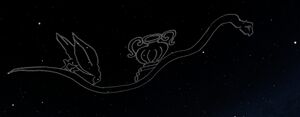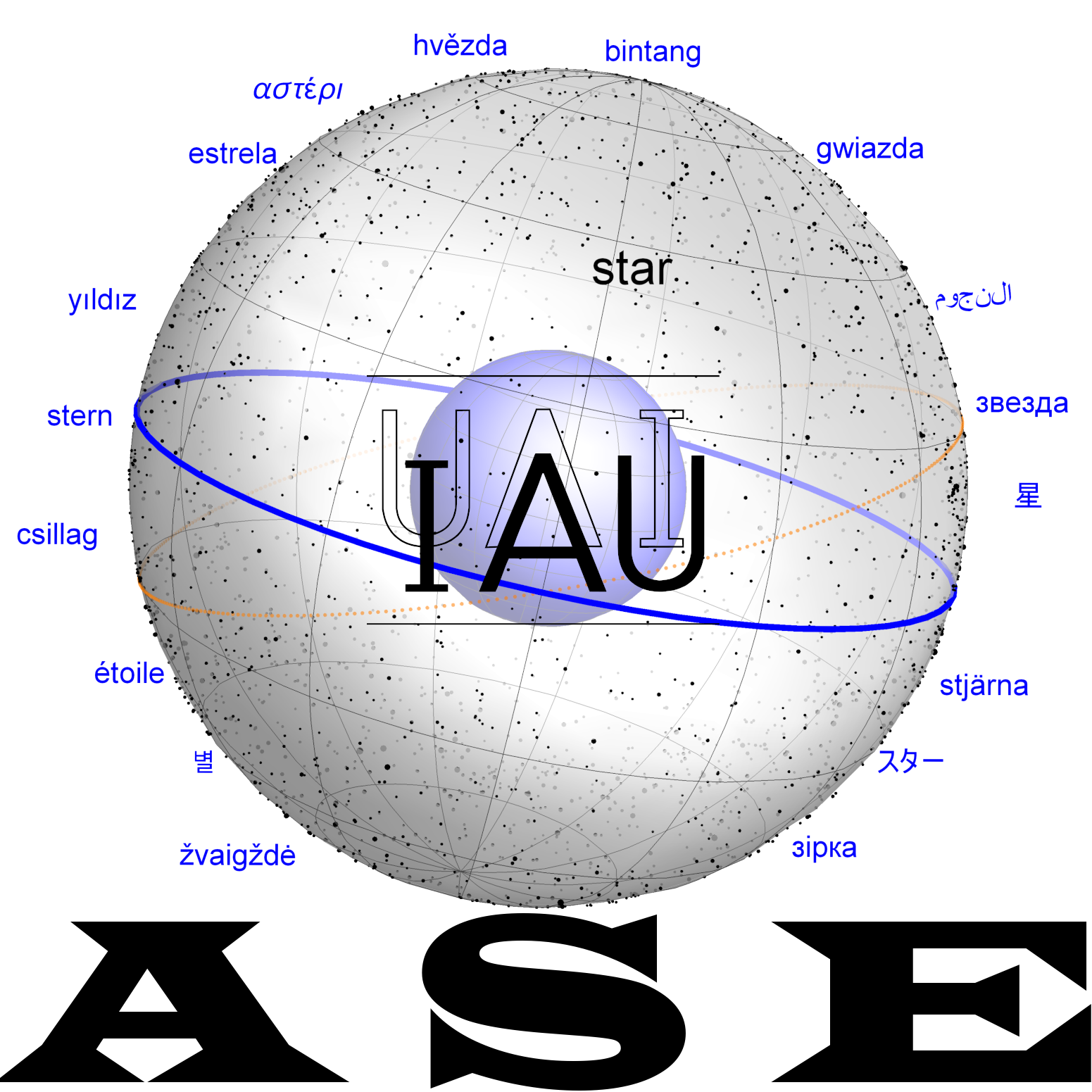Hydra
One of the 88 IAU constellations. The name "Hydra" refers to a watersnake from Greek mythology. Still, the underlying constellation originally referred to a Babylonian creature that consisted of a dog-headed snake with wings, the mul (d)MUŠ.
Etymology and History
The Greek constellation of the Water Snake is a derivative of the Babylonian constellation of the MUŠ-Dragon, a dog-headed creature with the body of a gigantic snake with front legs and wings.
Origin of Constellation
The Babylonian constellation is mentioned as early as 2nd millennium BCE; it occurs in lexical texts and texts of the Three Stars Each-genre. It is also mentioned in the first list (uranology) of MUL.APIN, where the Raven (or Crow) is mentioned at the tip of the tail of the huge creature in the sky.
Aratus
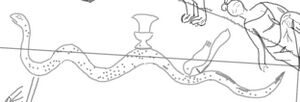
But yet another constellation sweeps across the horizon: they call it the Hydra. Like a living thing [445] it winds at great length, its head comes below the middle of the Crab, its coil under the Lion’s body, and its tail hangs over the Centaur himself. On its middle coil lies the Bowl, and on the last one the figure of a Raven that looks like one pecking the coil. [450] Yes, and there too Procyon shines brightly beneath the Twins. (Kidd 1997)
For Aratus pi Hya is part of the snake which can be derived from the simultaneously setting constellations (663).
Eratosthenes
Eratosthenes in his Catasterismi gives two sections per constellation: First, he describes the story that led to the object/ animal/ god becoming a constellation. Then, he describes the positions of the stars in the figure.
This constellation is plural because of one event event. The raven is associated with the cult of Apollo, as a bird is dedicated to each of the gods. As the gods were making a sacrifice, he was sent to a fountain to collect a libation; seeing a fig tree near the fountain bearing figs that were unripe figs, he waited for them to ripen; after a while, when they were time, when they were ripe and he had eaten the figs, realising eaten the figs, realising that he had committed a sacrilege, he also seized the hydra that was in the fountain and brought it with the cup, claiming that the hydra had been drinking day after day from the spring. But Apollo discovered what had happened and imposed on the raven a punishment commensurate with his fault : to be thirsty among men at this time of year as Aristotle says in his books On Beasts. For leave a clear reminder of the sacrilege that had been committed against the gods, Apollo represented and placed among the constellations the Hydra, the Crater, and the Raven who cannot drink from it or go near it. The Hydra has three bright stars on the tip of its head head, six on its first fold, the last of which is bright, three on the second fold, four on the third, two on the fourth, and nine stars without brilliance which go from the fifth fold to the tail. In all, twenty-seven. The Raven is located on the tail of Hydra and looks towards the setting sun. It has a star without luster on the beak, two on the wing, two on the rump, and one on the tip of the legs. In all, seven. The Crater is located on the Hydra, at a certain distance from the fold, and is inclined towards the knees of the the Virgin. The Crater has two stars without luster on the rim, two in the centre of the Cup, and two at the the base. In all, six. (Pamias and Zucker 2013)
Ancient Greek
English (our translation)
Hydra to which also belongs the Cup and the Raven
This constellation is plural [a super-constellation] because of one event. The raven is associated with the cult of Apollo, as a bird is dedicated to each of the gods. As the gods were making a sacrifice, he was sent to a fountain to collect a libation; seeing a fig tree near the fountain bearing figs that were unripe, he waited for them to ripen. At the time, when they were ripe and he had eaten the figs. Realising that he had committed a sacrilege, he also seized the watersnake (hydra) that was in the fountain and brought it with the cup, claiming that the hydra had been drinking day after day from the spring. But Apollo discovered what had happened and imposed on the raven punishment commensurate with his fault: to be thirsty among men at this time of the year, as Aristotle says in his books On the Animals. For the sacrilege that had been committed against the gods, Apollo placed the Hydra, the Crater, and the Raven, who cannot drink or bath among the constellations.
The Hydra has three bright stars on the tip of its head, six on its first fold, the last of which is bright, three on the second fold, four on the third, two on the fourth, and nine stars without brilliance which go from the fifth fold to the tail. In all, twenty-seven. The Raven is located on the tail of Hydra and looks towards the setting sun. It has a star without luster on the beak, two on the wing, two on the rump, and one on the tip of the legs. In all, seven. The Crater is located on the Hydra, at a certain distance from the fold, and is inclined towards the knees of the Virgin. The Crater has two stars without luster on the rim, two in the centre of the Cup, and two at the base.
Hipparchus
| Greek
(Manitius 1894) |
German
(Manitius 1894) |
English | |
|---|---|---|---|
| weiter giebt Eudoxos auch die auf den sogenannten Kolurkreisen gelegenen Sterne an und behauptet, auf dem einen derselben liege die Mitte des Großen Bären, die Mitte des Kreises, der Nacken der Wasserschlange und von der Argo das Stück zwischen dem Hinterteil und dem Mastbaum; alsdann nach dem unsichtbaren Pol der Schwanz des südlichen Fisches, die Mitte des Steinbocks und die Mitte des Pfeils; endlich gehe er durch den Hals und den rechten Flügel des Schwans, durch die linke Hand des Kepheus, durch die Windung der Schlange und vorbei am Schwanze des Kleinen Bären. | Eudoxus also gives the stars situated on the so-called circles of Colur and claims that on one of them lies the centre of the Great Bear, the centre of the circle, the neck of the watersnake and the part of the Argo between the rump and the mast; then, after the invisible pole, the tail of the southern fish, the centre of Capricorn and the centre of the arrow; finally, it passes through the neck and the right wing of the swan, through the left hand of Cepheus, through the coil of the Snake and past the tail of the Little Bear. | Lib. I. Cap. XL § 9 . | |
| Ersichtlich macht er dies auch bei dem Aufgange der Fische, wo er sich also ausdrückt; nachdem er nämlich von der Wasserschlange gesagt, daß das Stück vom Kopfe bis zur ersten Windung, wenn der Wassermann im Aufgange begriffen ist, nicht mehr über dem Horizont sei, während den Rest ihres Körpers die Fische hinabführen. | He also makes this evident in the rising of the fishes, where he expresses himself thus; for after he has said of the watersnake that the part from the head to the first coil, when the Aquarius is in the act of rising, is no longer above the horizon, while the rest of its body is led down by the fishes. | Lib. II. Cap. I. § 24 | |
| Untergang des Perseus, mitkulminierend:
Leo 5 1/2: Von der Wasserschlange der vierte von den vier hinter dem hellen nach Osten gelegenen (λ2), 1 Mbr. westlich des Meridians. |
Setting of Perseus, co-culminating:
Leo 5 1/2: Of the watersnake the fourth of the four behind the bright one to the east (λ2), 1 moon width west of the meridian. |
Lib. II, Cap.VI. §15 | |
| Aufgang des Kentaur, mitkulminierend:
Cnc 12°: Von der Wasserschlange der nachfolgende in der südlichen Kinnlade (η) |
Rising of the centaur, co-culminating:
Cnc 12°: From the watersnake of the following in the southern jaw (η) |
Lib. III. Cap. I. § 4. | |
| Untergang Kleiner Hund, mitkulminierend:
3 . Von der Wasserschlange der am Ende des Schwanzes (π). |
Downfall Small dog, co-culminating:
3 . From the watersnake at the end of the tail (π). |
Lib. III. Cap. n. § 13 | |
| Aufgang der Jungfrau, mitkulminierend:
2. Von der Wasserschlange der nördlichere von denen im Rachen (δ) , 1 Mbr. östlich des Meridians. |
Rising of Virgo, co-culminating:
2. of the watersnake the more northerly of those in the throat (δ), 1 moon width east of the meridian. |
Lib. III. Cap. III. § 3 | |
| Aufgang des Skorpions, mitkulminierend:
Von der Wasserschlange von den vieren nach dem hellsten [vor dem Becher] der dritte von Westen (ν2 Hydrae) |
Rising of the scorpion, co-culminating:
Of the watersnake of the four after the brightest [before the cup] the third from the west (ν2 Hydrae) |
Lib. III. Cap. III. § 5. |
The mathematical astronomer mentions this constellation rising and setting.
| Greek | German
(Manitius 1894) |
English
(from Manitius 1894) |
|
|---|---|---|---|
Die Wasserschlange (Hydra). Aufgang von Cnc 18 1/2 Grad bis Lib 15 1/2 Grad, Mitkulmination Ari 2 1/2 Grad bis Cnc 18 Grad.
Dauer des Aufgangs: 7 1/15 St. = 424m = 106°. |
The water snake (Hydra). Rising from Cnc 18 1/2 degrees to Lib 15 1/2 degrees, co-culmination Ari 2 1/2 degrees to Cnc 18 degrees.
Duration of the rise: 7 1/15 hours = 424m = 106°. |
Lib III, Cap. I, §1 | |
Die Wasserschlange (Hydra). Untergang von Gem 29° bis Vir 11°; Mitkulmination Lib 18 1/2 Grad bis Sgr 18 1/2 Grad.
Dauer des Untergangs: 4 St. = 240m = 60°. |
The watersnake (Hydra). Setting from Gem 29° to Vir 11°; co-culmination Lib 18 1/2 degrees to Sgr 18 1/2 degrees.
Duration of the setting: 4 hours = 240m = 60°. |
Lib. III. Cap. II. § 1. | |
| Greek | German | English | |
|---|---|---|---|
| Der nördlichere von denen im Rachen (δ). | |||
| Der aro Ende des Schwanzes (π) | |||
- The first star rising is ,
- the last star rising is the one at the tip of the tail (ὁ ἐν ἄκρᾳ τῇ οὐρᾷ).
Dauer des Aufgangs : 7 1/15 St. = 424m = 106°.
Further stars mentioned
| Greek
(Manitius 1894) |
German
(Manitius 1894) |
English
(...) |
|
|---|---|---|---|
| Von der Wasserschlange |
Hyginus, Astronomica
This is the sign on which the Crow sits and over which the Bowl is placed. The following reason has been handed down: When Apollo was sacrificing, the crow, who was under his guardianship, was sent to a spring to get some pure water. Seeing several trees with their figs not yet ripe, he perched on one of them waiting for them to ripen. After some days when the figs had ripened and the crow had eaten some, Apollo, who was waiting, saw him come flying in haste with the bowl full of water. For this fault of tardiness Apollo, who had had to use other water because of the crow's delay, punished him in this way. As long as the figs are ripening, the crow cannot drink, because on those days he has a sore [?] throat,. So when the god wished to illustrate the thirst of the crow, he put the bowl among the constellations, and placed the water-snake underneath to delay the thirsty crow. For the crow seems to peck at the end of its tail to be allowed to go over to the bowl.
Istros and several others have said that the Crow was Coronis, daughter of Phlegyas. She bore Aesculapius to Apollo, but after Ischys, son of Elatus, had lain with her, the crow, which had noted it, reported it to Apollo. For his unpleasant news Apollo changed him to black instead of his former white color, and transfixed Ischys with his arrows.
About the Bowl Phylarchus writes this tale: In the Chersonnese near Troy where many have said the tomb of Protesilaus is located, there is a city, Elaeusa by name. When a certain Demophon was ruling there, a sudden plague fell on the land with a strange death-rate among the citizens. Demophon, greatly disturbed by this, sent to the oracle of Apollo seeking a remedy, and was told that every year one girl of noble rank should be sacrificed to their household gods. Demophon, passing over his own daughters, would choose by lot one of the daughters of the nobles, and kept doing this until his scheme offended a certain man of highest rank. He said he wouldn't allow his daughter to be entered in the drawing unless the daughters of the king were included. The king, angered by this, killed the noble's daughter without drawing of lots. This deed Mastusius, father of the girl, for a time out of patriotism pretended he did not resent, for the girl might have perished if the lots had been taken. Little by little, time led the king to forget. When the girl's father had shown himself to be on most friendly terms with the king, he said he was going to make a solemn sacrifice and invited the king and his daughters to join the celebration. The king, suspecting nothing, sent his daughters ahead; since he was busy with a state affair, he would come later. When this happened as Mastusius wished, he killed the king's daughters, and mixing their blood with wine in a bowl, bade it be given as a drink to the king on his arrival. The king asked for his daughters, and when he learned what had happened, he ordered Mastusius and the bowl to be thrown into the sea. The cape where he was thrown, to memorialize him is called Mastusian; the harbour still is called the Bowl. Astronomers of old pictured it in the stars, so that men might remember that no one can profit from an evil deed with impunity, nor can hostilities often be forgotten. Some, with Eratosthenes, say that it is the bowl Icarus used when he showed wine to men; others the jar into which Mars was thrown by Otus and Ephialtes. (Mary Ward 1960)
Almagest
| Greek
(Heiberg 18xx) |
English
(Toomer 1984) |
ident. | ||
|---|---|---|---|---|
| τῶν έν τῇ κεφαλῇ ε τῶν ἡγοvμένωv β ὁ vοτιώτερος ἐπὶ τῶv μυκτήρων | 1 | The 5 stars in the head: the southernmost_of the 2 advance ones, which is on the nostrils | sig Hya | |
| ὁ βορειότερος αὐτῶν καὶ ἐπάνω τοῦ ὀφθαλμοῦ | 2 | The 5 stars in the head: the northernmost of these [2], which is above the eye | delta Hya | |
| τῶν ἑπομένων αὐτοῑς β ὁ βόρειος ῶς ἑπὶ τοῦ κρανίου | 3 | The 5 stars in the head: the northernmost of the 2 to tl1e rear ofthese, which is about on the skull | eps Hya | |
| ὁ vοτιώτερος αύτῶν καὶ ἑπὶ τοῦ χάσματος | 4 | The 5 stars in the head: the southernmost of them, on the gaping jaws | eta Hya | |
| ὁ πᾶσιv ἑπόμεvος ὡς ἑπὶ τῆς γένvος | 5 | The 5 stars in the head: the reannost of all, about on the cheek | zet Hya | |
| τῶν ἐv τῇ έκφύσει του τραχήλου β ὁ ἡγούμενος | 6 | The more advanced ofthe 2 star~ in the place where the neckjoins [the head) | omega Hya | |
| ὁ ἑπόμενος αὐτῶν | 7 | The rearmost of them | theta Hya | |
| τῶν ἑξης ἐν τῇ καμπῇ τοῦ τραχήλου γ ὁ μέσος | 8 | The middle star of the following three in the bend of the neck | tau2 Hya | |
| ὁ ἑπόμενος τῶν γ | 9 | The rearmost of the 3 | iota Hya | |
| ὁ νοτιώτατος αὐτῶν | 10 | The southernmost of them | tau1 Hya | |
| τῶν ἀπο νότου β συνεχῶν δ άμαvρος καὶ βόρειος | 11 | The faint, northernmost star of the 2 close tagether to the south | BSC 3750 | |
| ὁ λαμρὸς τῶν β συνεχῶν | 12 | The bright one of these two close stars | alpha Hya | |
| τῶν μετὰ τὴν καμπὴν ἑπομέvων γ ὁ ἡγούμενος | 13 | The most advanced ofthe 3 stars to the rear, afl:er the bend [in the neck | kappa Hya | |
| ὁ μέσος αὐτῶν | 14 | The middle one | upsilon1 Hya | |
| ὁ έπόμενος τῶν τριῶν | 15 | The rearmost of the three | upsilon2 Hya | |
| τῶv ἑξῆς ὠς ἐπ' εὐθείας γ ὁ ἡγούμενος | 16 | The most advanccd of the ncxt 3 stars almost on a straight line | mu Hya | |
| ὁ μέσος αυτῶν | 17 | The middle one | phi Hya | |
| ὁ έπόμενος τῶv τριῶν | 18 | The rearmost of the three | nu Hya | |
| τῶν μετὰ τὴν βάσιν τού Κρατῆρος β ὁ βορειότερος | 19 | The northernmost of the 2 stars aher [i.c. to the rear o.t] the base of Crater | beta Crt | |
| ὁ νοτιώτερος αυτῶν | 20 | The southernmost of thcm | chi1 Hya | |
| τῶv μετα τούτους γ ὡς ἐν τριγώνῳ ὁ ἡγούμενος | 21 | The most advanced of the 3 stars aller these, as it werc in a triangle | xi Hya | |
| ὁ μέσος αὐτῶν και νοτιώτερος | 22 | The middle and southernmost onc | omicron Hya | |
| ὁ έπόμενος τῶν τριῶv | 23 | The rearmost of the three | beta Hya | |
| ὁ μετα τὸν Κόρκα ἐv τῷ παρούρῳ | 24 | The star after Corvus, in the scction by the tail | gamma Hya | |
| ὁ ἐπ' ἄκρας τῆς οὐρᾶς | 25 | The star on the tip of the tail | pi Hya | |
| Stars round Hydra outside the constellation: | ||||
| ὁ ἐκ μεσημβρίας τῆς κεφαλῆς | 26 | The star to the south of the head | BSC 3314 | |
| ὁ ἐκ διαστήματος ἑπόμενος τοῑς ἐν τῷ τραχrjλῳ | 27 | The star some distance to the rear of those in the neck [ nos. 6-I5] | epsilon Sex | |
Transfer and Transformation of the Constellation
Mythology
Greek/ Greco-Roman folklore
Babylonian belief
IAU WGSN
The star pi Hydrae is very important in history as it is one of the keywitnesses for transfer from Hipparchus to Ptolemy.
- name in Hipparchus: ὁ ἐν ἄκρᾳ τῇ οὐρᾷ (the one at the farthest point of the tail)
- name in the Almagest: ὁ ἐπ᾽ἄκρας τῆς οὐρᾶς (the one at the end of the tail)
The Greek term ἄκρᾳ can be translated as "at the farthest point" or "at the end" (or "hightest" which doesn't apply here).
Weblink
References
- ↑ Hoffmann, Susanne M (2025), Some Results on the Ancient Globes, Globe Studies – The Journal of the International Coronelli Society, 69, 4169.
